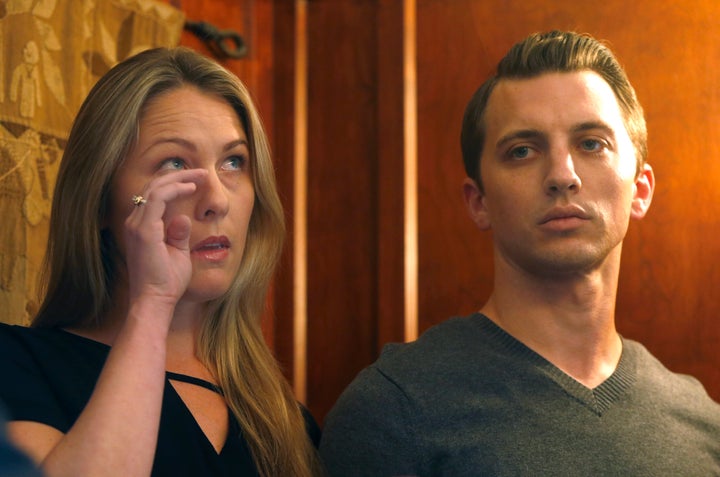This is an excerpt from our true crime newsletter, Suspicious Circumstances, which sends the biggest unsolved mysteries, white-collar scandals and captivating cases straight to your inbox every week. Sign up here.
Aaron Quinn called 911 just before 2 p.m. on Monday, March 23, 2015, saying that intruders dressed in scuba suits had broken into his upscale Northern California home in the middle of the night, tied him up and drugged him, kidnapped his girlfriend, Denise Huskins, and demanded ransom. Police had questions: Why did he wait so long to call authorities? Why was he so calm? And when he admitted that just the evening before, the couple had talked about his recent attempts to get back together with his ex-fiancée, their interview began to turn into an interrogation.
To investigators, this wasn’t a kidnapping ― it was murder, and the boyfriend did it. And then when Huskins reappeared, they refused to believe the abduction was real. Netflix’s new docuseries “American Nightmare,” which premieres Wednesday, is a scathing rebuke of authorities’ handling of what became known as the “Gone Girl” case: Huskins was accused of faking her kidnapping like the character in Gillian Flynn’s novel who staged her death and framed her husband for her murder.

s
Huskins Is Found
Huskins was alive, stuffed in the trunk of a car that was being driven to a remote cabin. If the police hadn’t confiscated Quinn’s phone — on which he’d already received a call from the kidnapper — and set it to airplane mode, they could have been able to see and potentially trace the kidnapper’s subsequent ransom calls to within about 200 yards from the spot where Huskins was being held. She was raped there, more than once, and forced to wear darkened swim goggles so she couldn’t see her captor.
Meanwhile, Huskins’ disappearance had sparked a media frenzy across the country, with pictures of the blue-eyed, blond-haired 29-year-old appearing in news stories about the strange case. San Francisco Chronicle crime reporter Henry Lee, who is interviewed in “American Nightmare,” became part of the case when he received an anonymous email with an audio message from Huskins. Her voice was oddly calm and unemotional as she confirmed her kidnapping, said she was “fine” and shared news of a plane crash that day to prove the timeliness of the message. No mention was made of ransom.
The case took another wild turn when, just 48 hours after her kidnapping and without any ransom being paid, Huskins turned up, seemingly unharmed, near her father’s Huntington Beach home, more than 400 miles south of where she’d been abducted. Before he let her go, the kidnapper — who’d convinced both Quinn and Huskins he was one of a group that had attacked them — reiterated what he’d told the couple during the home invasion: that Quinn’s ex-fiancée, Andrea, who had lived at the house until the previous September, had always been the intended target of the kidnapping.

Blaming The Victims
But Huskins’ ordeal was far from over. Within hours of her release, investigators, including from the Vallejo Police Department and the FBI, cast doubt on her story. She and Quinn were shocked when authorities shifted their suspicions to the couple, threatening to prosecute them for perpetrating a hoax and wasting government resources.
“If anything, it is Miss Huskins who owes this community an apology,” Vallejo police Lt. Kenny Park said at a news conference at the time.
Huskins and other women tied to the case were repeatedly disparaged by investigators. Her mother said that when she shared that Huskins had been molested when she was a child, Mustard told her that women who were sexually assaulted when they were young “often pretend to have it happen again, so they can relive the thrill of it.”
Authorities continued to treat the case as a massive hoax perpetrated by Quinn and Huskins, a narrative perpetuated by the media’s reporting. This seemed to outrage her very-real kidnapper, who emailed Lee, the Chronicle reporter, attaching pictures of a flashlight attached to a gun and a room where he said Huskins was being held — all consistent with Quinn’s and Huskins’ descriptions. The emailer also threatened to kidnap someone else if the Vallejo police did not issue an apology to the couple.
That apology never happened — even after their attacker was caught.
Heroes And Villains
Though most of the people involved in the investigation into Huskins’ kidnapping are painted in “American Nightmare” as villains — with Quinn’s and Huskins’ attorneys as their heroic protectors — its final episode focuses on the dogged detective work of Sgt. Misty Carausu, of the Dublin Police Department. She cracked Huskins’ case wide open when she identified Matthew Muller as a suspect in an eerily similar home invasion and attempted kidnapping in Dublin, nearly 40 miles south of Vallejo. At the crime scene, the suspect left his cellphone, which she traced to a remote cabin in South Lake Tahoe. After Muller, a former Marine and Harvard law school graduate, was arrested, Carausu found a long strand of blond hair stuck to a pair of swim goggles that had been covered with duct tape.
When Carausu made the connection to Huskins, she was appalled by the cavalier response when she alerted Vallejo investigators and the FBI.
“They are calling this woman a liar on national TV, but I just wanted to reach through the computer, give her a hug and say, ‘I got you,’” she says on “American Nightmare.”
Muller was eventually charged with Huskins’ kidnapping and pleaded guilty to kidnapping, robbery and rape charges. He never revealed why Andrea — who was later revealed to have dated David Sesma, the lead FBI agent on the case — was a target.
Huskins and Quinn, who are now married with two daughters, sued the city of Vallejo for defamation and settled out of court for $2.5 million.
In the docuseries, Carausu said through tears that she felt “an overwhelming sense of relief” that Huskins was finally “validated” after authorities had called her a liar.
“All I’ve wanted this whole time was someone in law enforcement to call a hero,” Huskins said, and Carausu was “our hero.”

